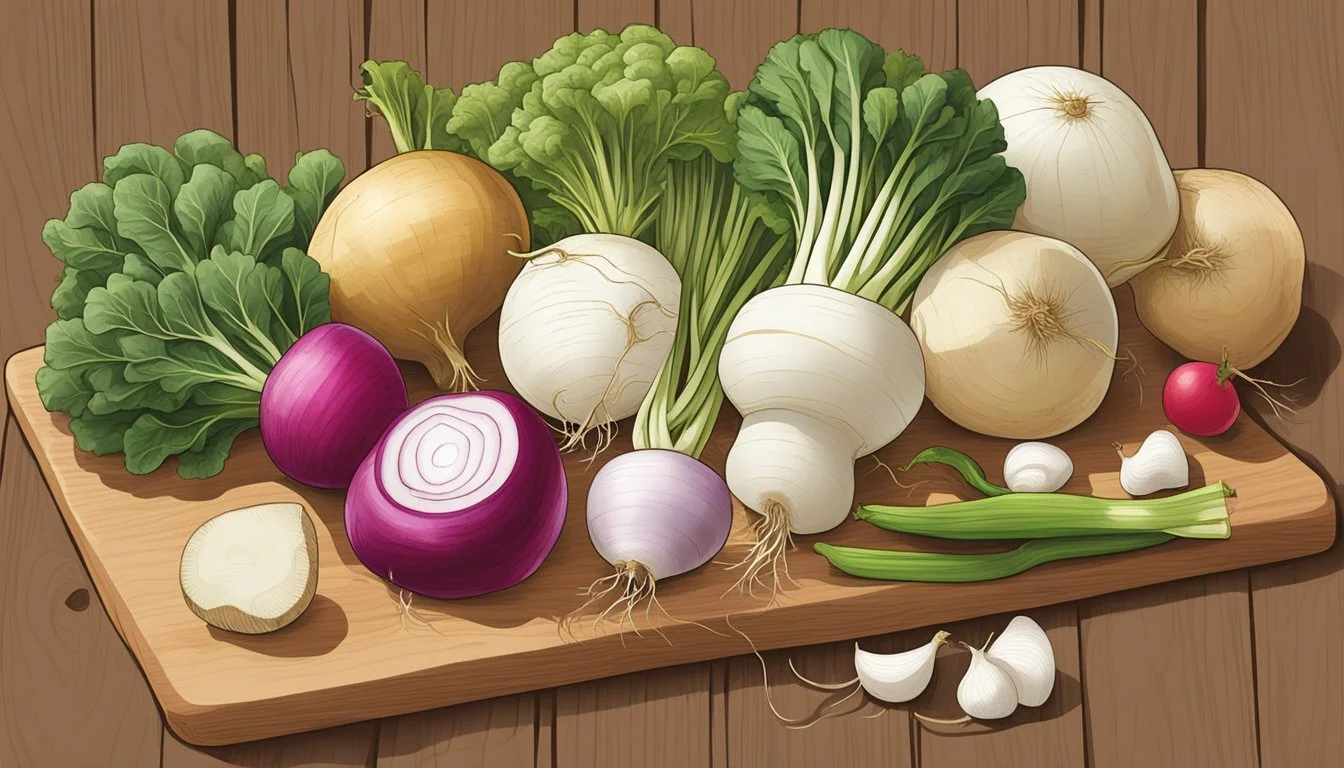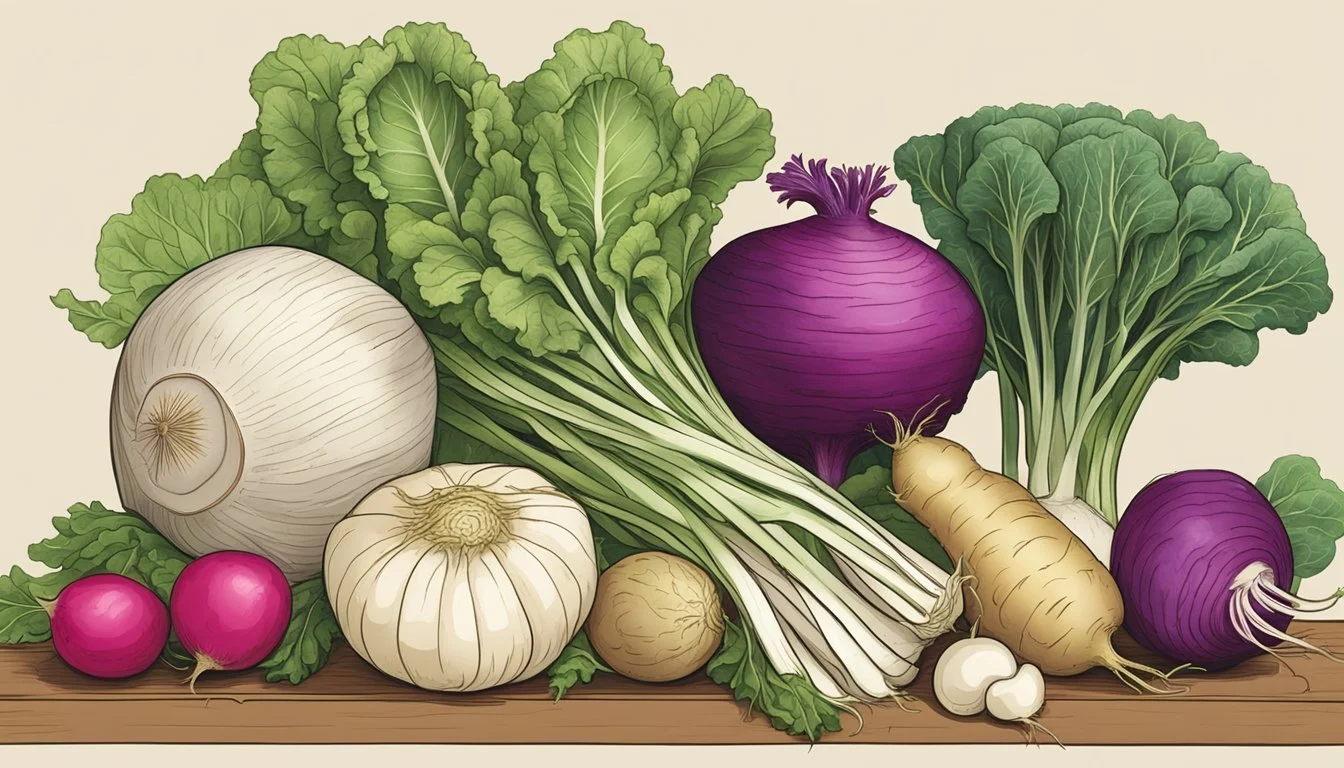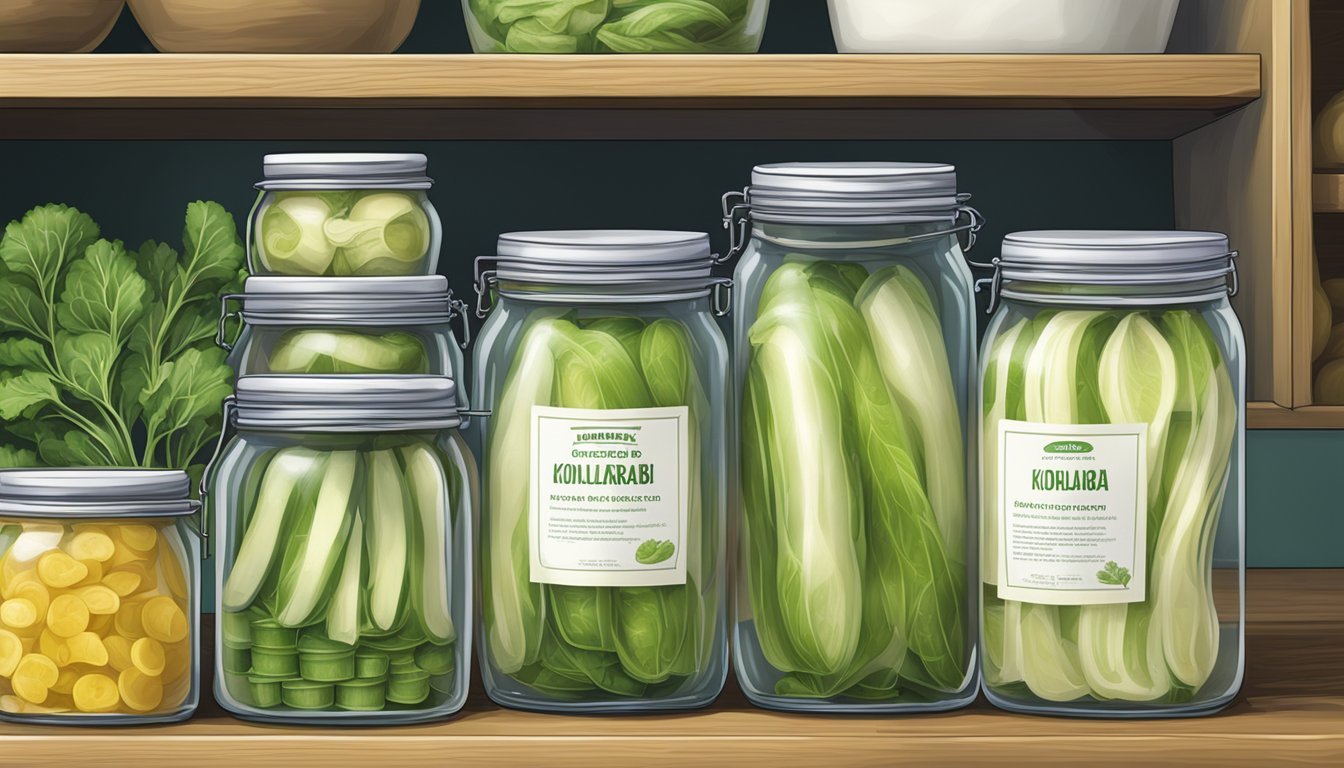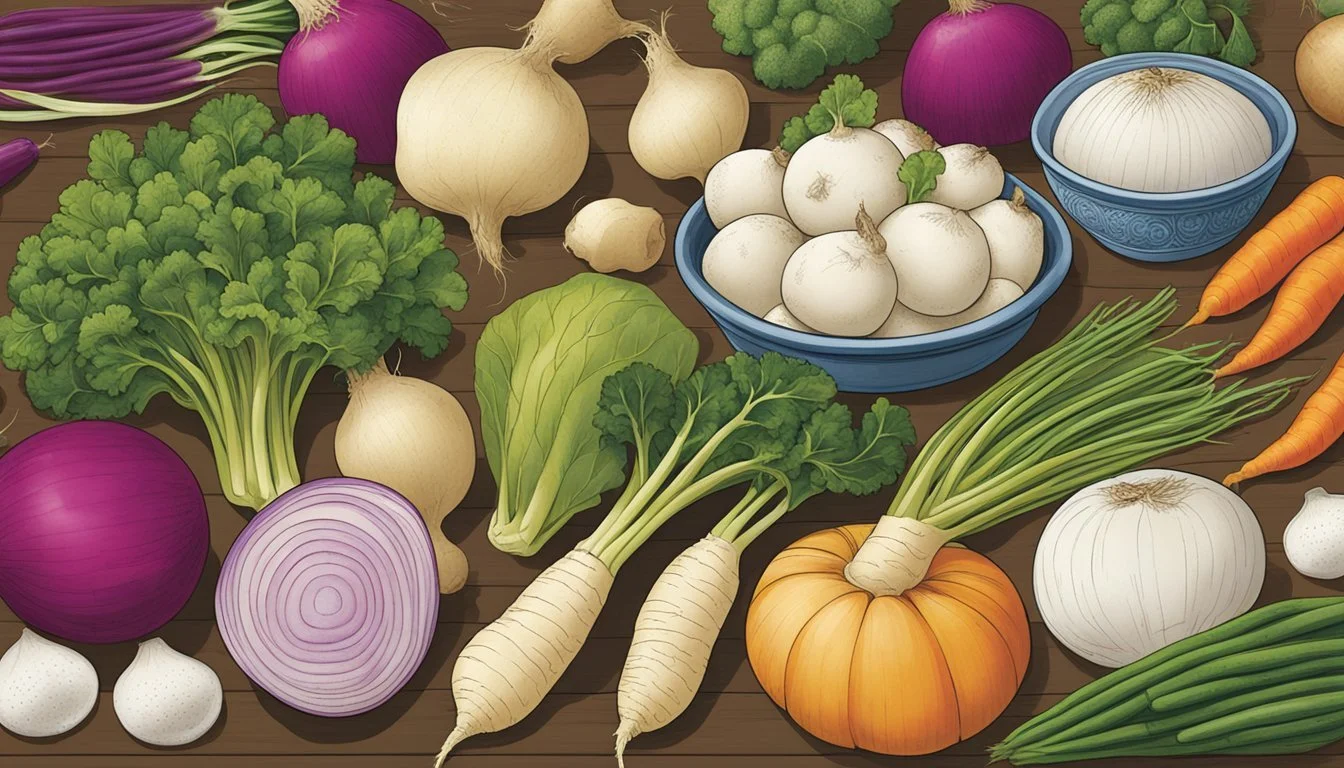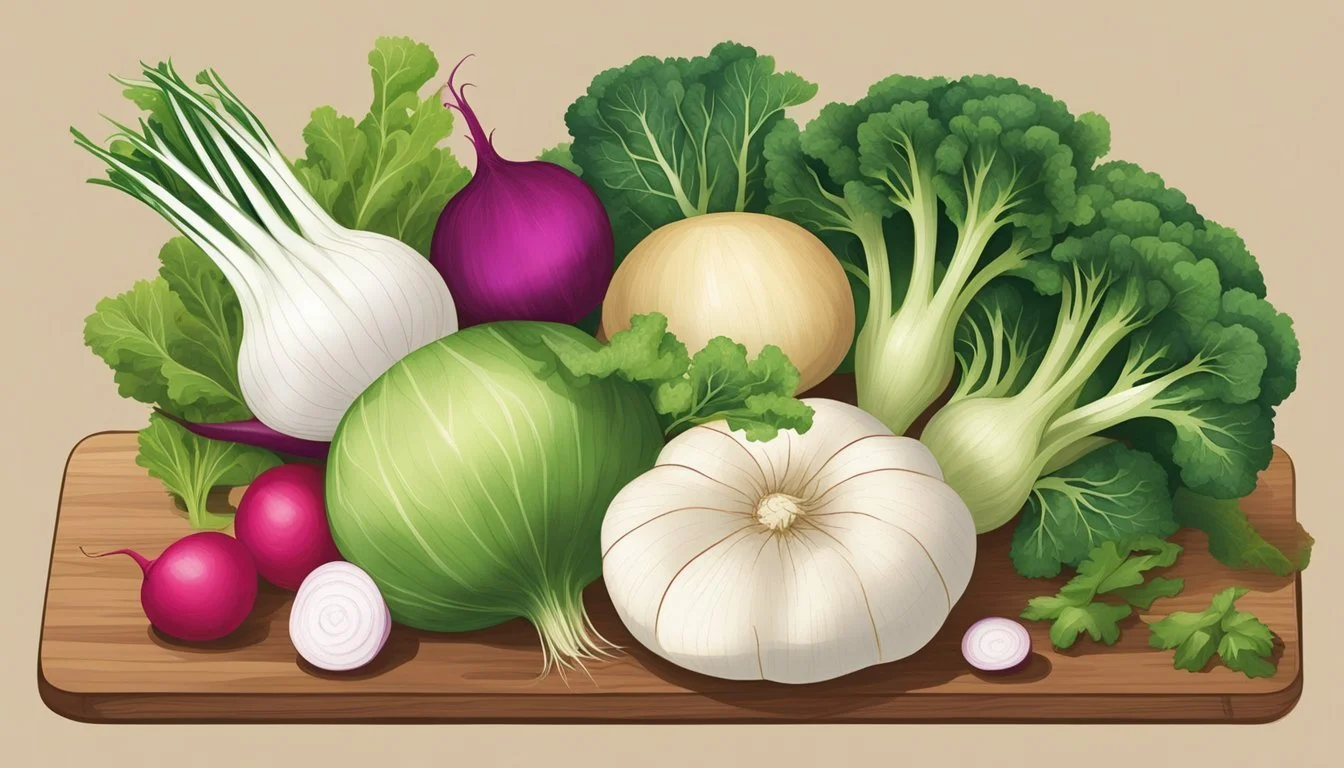Kohlrabi Substitutes
Top Alternatives for Your Recipes
Kohlrabi, a member of the cruciferous vegetable family, is known for its turnip-like flavor and crisp texture. It can be eaten raw or cooked and is commonly used in a range of dishes from salads to stir-fries. However, its availability may vary by region and season, necessitating a need for substitutes that maintain the integrity of the recipes it graces.
When it is not available, several other vegetables offer similar qualities that make them excellent replacements. Radishes, with their peppery bite, can be used raw in salads or cooked, adding a similar crispness. Broccoli stems, often discarded, have a milder, sweet taste and a satisfying crunch that mirrors kohlrabi's texture well in cooked applications. Jicama, a root vegetable with a mildly sweet flavor and notable crunch, serves as another suitable alternative, especially in dishes where a fresh, crisp component is desired.
To further mimic kohlrabi’s characteristics in recipes, turnips, with their subtly sweet and earthy taste, can be a nutritious choice. In addition, cauliflower's mild flavor and versatility in cooking make it a reliable stand-in for kohlrabi in various preparations from roasting to steaming, ensuring that the outcome of dishes remains consistent in both flavor and texture.
Understanding Kohlrabi
As a distinctive root vegetable, kohlrabi offers a unique combination of flavors and nutrition, making it a versatile ingredient in many dishes. This section delves into the essentials of kohlrabi: its nutritional makeup, culinary versatility, and distinct physical attributes.
Nutritional Profile
Kohlrabi, often referred to as a German turnip, is a cruciferous vegetable that comes packed with a wealth of health benefits. It's rich in dietary fiber, vitamin C, and contains an array of antioxidants and minerals such as potassium, which are essential for maintaining a healthy diet.
Nutrient Value per 100g Dietary Fiber 3.6 g Vitamin C 62 mg Potassium 350 mg Antioxidants Present
Kohlrabi's nutritional benefits make it a healthy addition to any meal, aiding in digestion and contributing to overall well-being.
Culinary Uses
Kohlrabi is highly regarded for its versatility in the kitchen. It can be consumed raw or cooked, lending itself to various culinary applications. The vegetable is commonly used in salads for a crunchy texture or in cooked dishes where it adopts a softer consistency. It adds a tasty and nutritious element whether it is pureed for soups, roasted, sautéed, or included in stir-fries.
Physical Characteristics
In terms of appearance, kohlrabi is available in two main color varieties: green kohlrabi and purple kohlrabi. Regardless of the color, they typically have the same flavor and texture. The vegetable has a bulbous stem and green leaves, which are also edible. Its texture is similar to that of a broccoli stem but with a milder and slightly sweet taste.
Attribute Description Color Varieties Green kohlrabi, Purple kohlrabi Texture Crisp; becomes soft when cooked Taste Mild and slightly sweet Edible Parts Bulbous stem and green leaves
Understanding these characteristics of kohlrabi aids in selecting the best substitutes that closely match its unique qualities.
Common Kohlrabi Substitutes
Kohlrabi, with its crisp texture and mild, sweet flavor, is a versatile vegetable in the kitchen. Below are categorized common substitutes that maintain a similar texture and flavor profile to kohlrabi, making them excellent alternatives in various culinary applications.
Root Vegetable Alternatives
Radishes: They offer a crisp texture with a slight peppery kick, making them suitable for raw applications. Use equal amounts when substituting for kohlrabi.
Turnips: These can add a spicy yet sweet flavor and are another crisp alternative. They work well in cooked dishes.
Parsnips: Parboil to reduce their inherent sweetness if looking for a closer match to kohlrabi's flavor.
Celeriac/Celery Root: This knobby root imparts a similar earthy tone to dishes and can mimic kohlrabi's role well in recipes.
Rutabaga: A gentle sweetness with a robust texture makes rutabaga a hearty stand-in, especially in stews and roasts.
Cruciferous Vegetable Alternatives
Broccoli Stems: These stems closely match kohlrabi in both texture and flavor. Use them peeled and either raw or cooked.
Cauliflower: With its neutral profile and firmness, cauliflower is excellent both raw and cooked. It can be chopped finely as a kohlrabi alternative.
Cabbage: It can replace kohlrabi in recipes that call for a more leafy texture, and when chopped, imitates kohlrabi's mild character.
Leafy Green Alternatives
Swiss Chard: The stalks of swiss chard can echo the texture of kohlrabi, and its leaves work well when a recipe calls for kohlrabi leaves.
Kale/Collards: Sturdy greens such as kale and collards may be used, particularly in cooked dishes; they bring a similar, although slightly more robust flavor.
Selecting the Best Substitute
Choosing an appropriate kohlrabi substitute requires consideration of the dish's texture and flavor profile. Whether used raw or cooked, the replacement should complement the original recipe's intent.
For Raw Preparations
In raw dishes such as salads and slaws, a substitute should offer a crisp texture and a flavor that blends well with other ingredients.
Jicama: Offers a mildly sweet and crisp texture, matching kohlrabi's crunch. Use it in equal amounts in salads and slaws.
Radishes: Provide a peppery kick and are best when sliced thinly for a texture akin to raw kohlrabi.
For Cooking
When cooked, substitutes should maintain structural integrity and contribute a compatible flavor to the dish.
Broccoli Stems: With a mild and slightly sweet taste, they work well in stir-fries and sautéed dishes.
Cauliflower: This cruciferous vegetable offers a mild flavor and a satisfying crunch. It is versatile in roasting, steaming, soups, and casseroles.
Turnips: These can be roasted, pickled, or slow-cooked. They bring a sweet and slightly bitter note, and share a similar texture with kohlrabi when cooked.
Selecting the suitable substitute depends largely on the method of preparation—raw or cooked—and the desired outcome of your recipe.
Preparing Substitutes
When substituting for kohlrabi in recipes, precise cutting and proper cooking methods are essential to achieve a similar texture and flavor profile. Ensuring that vegetables are prepared correctly can make a significant difference in the final dish.
Cutting Techniques
Mandolin: Utilizing a mandolin ensures consistent thickness, beneficial for vegetables like radishes or jicama when substituted for kohlrabi. Thin, even slices are ideal for salads or sandwiches.
Knife: A sharp chef's knife is versatile for cutting vegetables into shapes suited for different recipes, from julienne for stir-fries to cubing for roasts.
Cooking Methods
Stir-fry: Vegetables like jicama or broccoli stems, cut into uniform pieces, work well stir-fried over high heat with a small amount of oil. This method retains their crunch, akin to kohlrabi.
Sautéing: Substitutes like cauliflower or cabbage can be thinly sliced and quickly sautéed to bring out a natural sweetness while keeping the dish light.
Roasting: Vegetables such as cauliflower or broccoli stems can be roasted to concentrate their flavors, making them a hearty stand-in for kohlrabi in warm dishes.
Mashing: While not a common technique for kohlrabi, vegetables like cauliflower can be steamed and mashed for a smooth texture in purees or as a side dish.
Maximizing Flavor and Texture
When selecting a substitute for kohlrabi, one prioritizes maintaining the unique blend of mild sweetness and crisp texture that characterizes the original vegetable. Several alternatives offer comparable flavors and textures, making them suitable for recipes that traditionally include kohlrabi.
Taste and Flavor
Jicama: Possesses a sweet and light flavor, coupled with a refreshing crunch that resembles kohlrabi.
Broccoli Stems: Exhibits a slightly sweet taste and firmness akin to kohlrabi's stem. To use, simply peel and chop.
Texture
Celeriac: Offers a similar earthy taste, though more intense, its texture can mimic kohlrabi's crunch when eaten raw or retain a satisfying bite when cooked.
Turnips: Brings a spicy yet sweet profile with a juicy texture that's comparable to kohlrabi when raw.
Cauliflower: Contributes a mild but notably less sweet flavor. However, its satisfying crunch makes it an ideal stand-in for kohlrabi in cooked dishes.
The trick to maximizing flavor and texture in kohlrabi substitutes lies in preparation. With raw dishes like salads, one should aim to mimic the crispness of kohlrabi, ensuring the vegetable used is fresh and firm to the bite. When cooking, it's essential to adapt the substitute to the desired outcome, whether it's roasted to enhance a sweet flavor or steamed to preserve a subtle taste and firm texture. With these substitutes, recipes can achieve a balance of sweetness and crunch without compromising the integrity of the dish.
Storage and Preservation
When preserving kohlrabi, understanding its shelf life and proper storage techniques is essential. Fresh kohlrabi can last for several weeks, but proper handling can extend its usability.
Refrigeration: For short-term storage:
Place kohlrabi in the vegetable crisper of your refrigerator.
Store them in a loose plastic or paper bag to balance moisture levels and minimize ethylene exposure from other produce.
Whole kohlrabi bulbs should last up to a few weeks, while the leaves are best used within a few days.
For longer storage:
Blanched kohlrabi can be frozen:
Steps Details 1. Blanch Submerge in boiling water for a few minutes. 2. Ice Bath Transfer to an ice water bath to halt cooking. 3. Dry Pat the kohlrabi dry to remove excess moisture. 4. Freeze Place in airtight containers or freezer bags.
Frozen kohlrabi maintains quality for several months.
Preservation Techniques:
Kohlrabi can be pickled to extend its shelf life and add flavor.
Pickling involves submerging cut pieces into a vinegar-based brine.
Store pickled kohlrabi in airtight jars in a cool, dark place or refrigerate.
Tips for Preserving Quality:
Limit exposure to air and moisture to prevent spoilage.
Check stored kohlrabi periodically for signs of softening or mold.
Use pieces with higher water content first, as they spoil faster than denser parts.
Health Considerations
When considering substitutes for kohlrabi in a diet, it is important to examine the nutritional profile of the alternatives. Kohlrabi is known for its rich content of dietary fiber, vitamins, and minerals, which contribute to its health benefits.
Cauliflower is a noteworthy replacement, particularly for those monitoring their carbohydrate intake. It contains fewer calories and carbohydrates than kohlrabi, while still offering a robust amount of vitamin C and fiber. This cruciferous vegetable is also popular for its versatility and can be a nutritious addition to various dishes.
Jicama is another excellent option for its low-calorie count and high fiber content, which aids in digestion. This root vegetable is a source of vitamin C and potassium. Its antioxidant properties are beneficial for maintaining overall health.
For those seeking a substitute with familiar textures, radishes and broccoli stems provide a crispness similar to kohlrabi, without compromising on the intake of fiber and vitamins. Moreover, radishes contain minerals that are essential for bone health.
Turnips, with their mild flavor, offer a similar profile of vitamins and minerals. Especially high in antioxidants, turnips are a nutritious swap for kohlrabi in a variety of culinary applications.
The table below summarizes the health considerations for each kohlrabi substitute:
Substitute Fiber Vitamin C Potassium Antioxidants Calories Cauliflower High High Moderate Moderate Low Jicama High High High High Low Radishes Moderate Moderate High High Low Broccoli Stems Moderate High Moderate Moderate Low Turnips Moderate Moderate High High Low
By including these substitutes in their meals, individuals can maintain or enhance the nutritious quality of their diets, while also enjoying a variety of textures and flavors.
Exploring Cultural Recipes
When seeking variety for culinary creations, introducing kohlrabi substitutes into traditional dishes can offer a delightful twist. Many cultures utilize this distinctive vegetable in their cooking, and swapping it with alternatives allows cooks to experiment while still honoring the essence of the recipes.
In German cuisine, kohlrabi is often found in soups and salads. A chef might use jicama as a substitute to maintain the crunchy texture typical in these dishes. Equally, daikon radishes, with their sharp and tangy profile, can provide a similar bite in dishes such as sauerkraut or latkes.
Asian recipes frequently incorporate vegetables for texture and flavor. Daikon radishes are a natural fit for stir-fries and salads, standing in for kohlrabi in terms of mouthfeel and mild piquancy. The radishes can be easily sliced with a mandolin for uniformity, enhancing the dish's presentation.
For a hearty casserole that demands kohlrabi's sturdiness, turnips offer a robustness that withstands slow cooking, making them a natural kohlrabi counterpart. As a root vegetable, turnips carry the earthy notes suitable for these types of recipes.
Substitute Best Used In Texture Flavor Profile Jicama Salads, Latkes Crunchy Mild, slightly sweet Daikon Radish Stir-fries, Soups Crisp Sharp, tangy Turnips Casseroles Firm Earthy, subtly sweet
One searching for kohlrabi at a farmers’ market might instead select these substitutes, all of which can be found fresh and used to make culturally inspired dishes with a novel take on traditional recipes.
Conclusion
When seeking alternatives for kohlrabi in recipes, one has a variety of options that can closely mimic its flavor and texture. Radishes provide a similar crispness, ideal for raw applications such as salads. Jicama, too, shares a crispy texture with a slightly sweet note, making it another excellent option for slaws or stir-fries.
Broccoli stems should not be overlooked. Often discarded, they are a worthy substitute with a mildly sweet taste that complements dishes typically reserved for kohlrabi. These stems bring both nutritional value and crunch to a range of recipes.
For cooks who desire to maintain the integrity of their dishes without kohlrabi, these substitutes not only deliver comparable taste profiles but also ensure the texture remains consistent. Incorporating these alternatives into meals allows for an exploration of diverse ingredients while still achieving the desired outcome of the original recipe.
It is important to note that each substitute may bring its own unique element to dishes, and quantities may need slight adjustments. Experimentation is key in discovering the perfect balance that will satisfy the palate.

